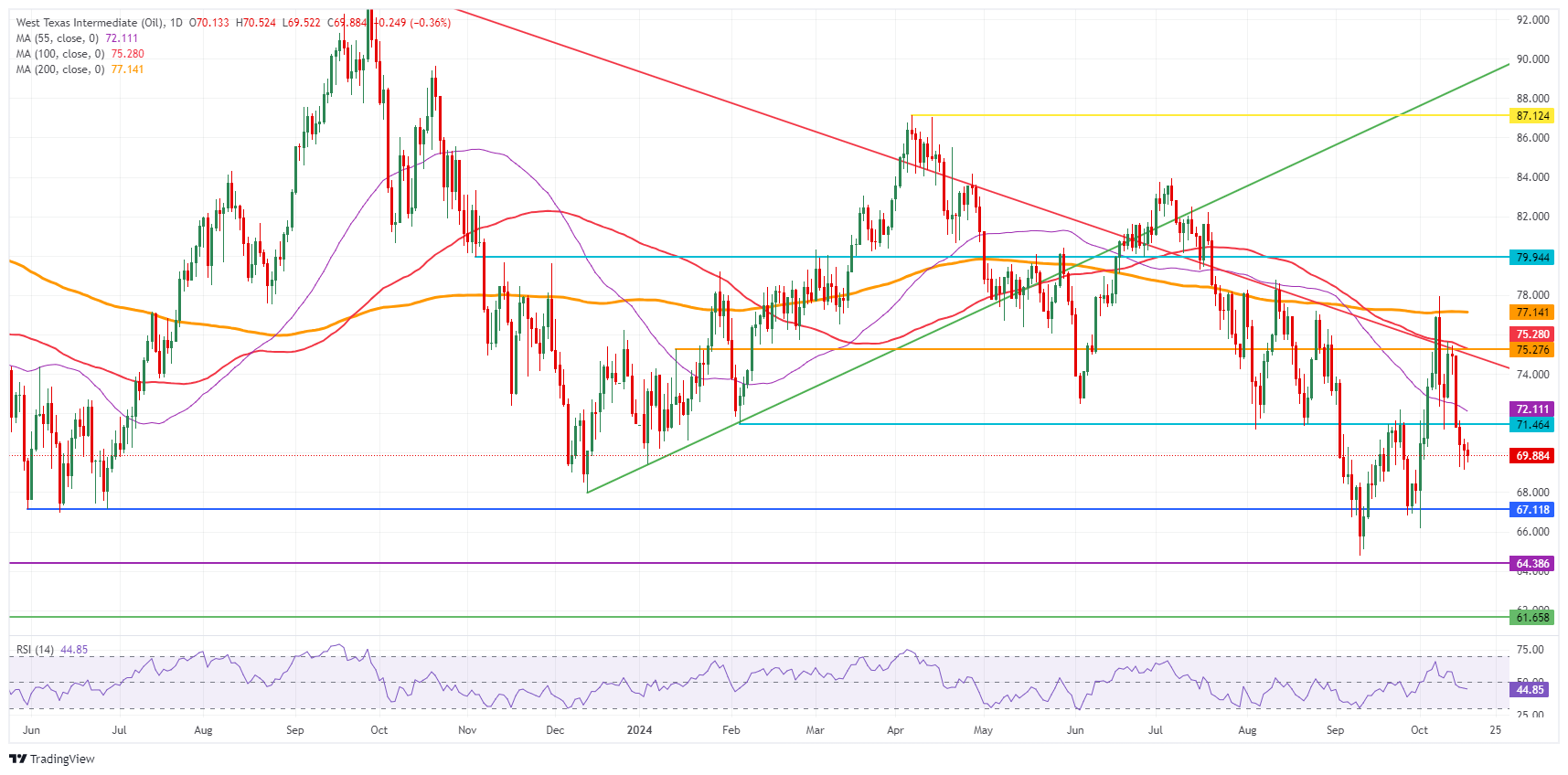- Crude oil prices find support and stabilize from their weekly low of $69.15 on Thursday.
- Overnight weekly API numbers showed an unexpected decline.
- The US Dollar Index breaks above a key level on its way towards 104.00.
Crude oil finds a bottom and stabilizes for now on Thursday after a four-day streak of losses, which is currently still down nearly 7% for the week. The ground beginning to form comes with traders doubting whether Israel’s Prime Minister Benjamin Netanyahu will keep his promise to the United States (US) not to attack Iranian oil facilities. Additional support came with the American Petroleum Institute’s (API) weekly overnight inventory numbers, which showed an unexpected draw of 1.58 million barrels in the week ending October 11 compared to an expected build of 2.3 million barrels.
The US Dollar Index (DXY), which tracks the performance of the Dollar against six other currencies, is set for a volatile session. The European Central Bank (ECB) has cut by 25 basis points, which could boost demand in the Eurozone. Meanwhile, US retail sales were strong at 0.4% versus 0.3% expected, meaning the US consumer is still willing to spend and shop, pointing to healthy domestic demand.
At the time of writing, Crude Oil (WTI) is trading at $70.21 and Brent Crude at $74.22.
Oil news and market factors: Will Israel challenge the US?
- China has announced a support plan for its domestic real estate market. The investment size will be 4 trillion yuan (CNY), while earlier this week, on Monday, a message of approximately 6 trillion yuan was communicated. Asian markets did not react well to the lower number, according to Bloomberg.
- Pressure continues to mount on Israel’s Prime Minister Benjamin Netanyahu to ignore the US request not to attack Iranian oil facilities. Unrest is now growing even within his cabinet after an article in the Jerusalem Post on Tuesday by the opposition leader calling for an immediate attack on Iranian facilities, Reuters reports.
- At 15:00 GMT, the Energy Information Administration (EIA) will publish its weekly inventory change numbers for the week ending October 11. A small build of 2.3 million is expected compared to the previous build of 5.81 million the previous week.
Oil Technical Analysis: The ground still holds
Crude oil struggles to maintain the $70.00 mark, but it will not be an easy task from here. Although lingering geopolitical tensions could quickly push crude oil prices higher, things could quickly fall apart if no events occur. As several other asset classes move with markets hedging for a potential presidential victory for former US President Donald Trump in the November 5 US presidential election, it is clear that crude oil has no idea how to assess a Trump victory.
There is a challenging path to crude oil recovery in the coming days. First, the pivot level at $71.46, which was strong enough to catch the falling knife on Monday, must recover again with a daily close above it. From there, the sizable technical level at $75.28, with the 100-day SMA and some pivot lines, is possibly the first major hurdle ahead.
On the downside, that previously mentioned pivot level of $71.46 has now become resistance and is no longer valuable as support. Instead, traders should look much lower, at $67.11, a level that supported the price in May-June 2023. Should that level be broken, the 2024 year-to-date low emerges at 64.75 $ followed by $64.38, the 2023 low.
US WTI Crude Oil: Daily Chart
WTI Oil FAQs
WTI oil is a type of crude oil that is sold in international markets. WTI stands for West Texas Intermediate, one of the three main types that include Brent and Dubai crude. WTI is also known as “light” and “sweet” for its relatively low gravity and sulfur content, respectively. It is considered a high-quality oil that is easily refined. It is sourced in the United States and distributed through the Cushing facility, considered “the pipeline junction of the world.” It is a benchmark for the oil market and the price of WTI is frequently quoted in the media.
Like all assets, supply and demand are the main factors that determine the price of WTI oil. As such, global growth can be a driver of increased demand and vice versa in the case of weak global growth. Political instability, wars and sanctions can alter supply and impact prices. The decisions of OPEC, a group of large oil-producing countries, is another key price factor. The value of the US Dollar influences the price of WTI crude oil, as oil is primarily traded in US dollars, so a weaker Dollar can make oil more affordable and vice versa.
Weekly oil inventory reports published by the American Petroleum Institute (API) and the Energy Information Agency (EIA) influence the price of WTI oil. Changes in inventories reflect the fluctuation of supply and demand. If the data shows a decline in inventories, it may indicate an increase in demand, which would drive up the price of oil. An increase in inventories can reflect an increase in supply, which drives down prices. The API report is published every Tuesday and the EIA report the next day. Their results are usually similar, with a difference of 1% between them 75% of the time. EIA data is considered more reliable since it is a government agency.
OPEC (Organization of the Petroleum Exporting Countries) is a group of 13 oil-producing nations that collectively decide member countries’ production quotas at biannual meetings. Their decisions often influence WTI oil prices. When OPEC decides to reduce quotas, it can restrict supply and drive up oil prices. When OPEC increases production, the opposite effect occurs. OPEC+ is an expanded group that includes ten other non-OPEC member countries, including Russia.
Source: Fx Street
I am Joshua Winder, a senior-level journalist and editor at World Stock Market. I specialize in covering news related to the stock market and economic trends. With more than 8 years of experience in this field, I have become an expert in financial reporting.








